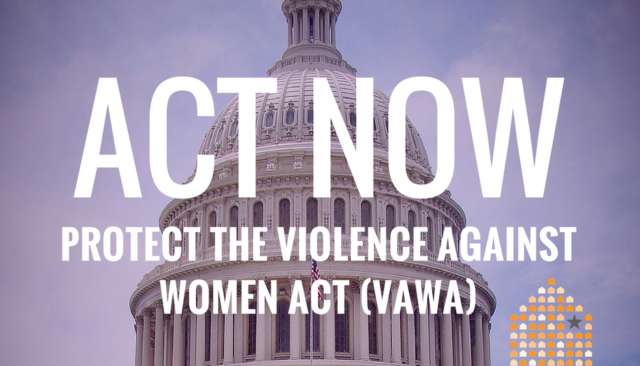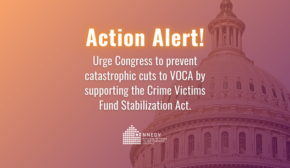“Reject proposed budget cuts” urges National Network to End Domestic Violence (NNEDV)
March 16, 2017
“Victims of domestic violence are fleeing for their lives,” said Kim Gandy, President and CEO of NNEDV. “Funding cuts for support and services put lives and families at risk.”
Today the President released the framework for his proposed FY18 budget (known as the skinny budget), with a more detailed budget to be released in May. The proposed framework, though scarce on details, includes proposed topline cuts that could impact programs that serve survivors, such as the Violence Against Women Act (VAWA) and the Family Violence Prevention and Services Act (FVPSA). Additionally, the budget calls for the elimination of key programs that are critical to victims of domestic violence, and reductions in other important programs.
The skinny budget framework proposes a topline cut of 18% to programs at the U.S. Department of Health and Human Services (HHS) and a 4% cut to the U.S. Department of Justice (DOJ). If these cuts were applied across the board to all programs at HHS and DOJ, approximately 260,000 fewer victims would be able to access shelters and supportive services provided by VAWA and FVPSA. “Even with current funding levels, although nearly 70,000 adults and children were served by domestic violence programs on a single day (24 hours) in 2015, there were nearly 12,000 requests for help on that same day that went unmet because programs lacked resources,” [1] said Gandy. “Our nation is in no position to cut funding for these vital programs. Programs need more funding, not less.”
Investments in the federal programs to address domestic and sexual violence have been incredibly successful. VAWA saved an estimated $12.6 billion in net averted costs in its first six years alone. [2] Reporting of domestic violence has increased as much as 51 percent. [3] The rate of non-fatal intimate partner violence against women has decreased by 63 percent [4] and the number of women killed by an intimate partner has decreased by 23 percent. [5] A 2010 study demonstrated that an increase in the availability of legal services is associated with a decrease in intimate partner homicide. [6] Another study found that VAWA funds, particularly the ones supporting law enforcement, were associated with a reduction in rape and aggravated assault. [7]
The budget framework would eliminate programs that help victims fleeing domestic violence achieve safety and stability, such as the Legal Services Corporation, the Low-Income Home Energy Assistance Program (LIHEAP), the HOME affordable housing program, and the Community Development Block Grants that fund shelter, housing, economic opportunities and supportive services in communities across the nation. It reduces funding for the important Women’s, Infants, and Children Food and Nutrition Service (WIC) program, and would eliminate the U.S. Interagency Council on Homelessness which has brought federal agencies together to address the strong connection between domestic violence and homelessness.
In addition to specific cuts and eliminations noted above, the overall reduction in “non-defense discretionary” investments would have a compounding negative impact. Together, these cuts would reduce the social safety net and expose low-income and vulnerable populations, including victims of domestic violence, to greater insecurity.
“Investments in VAWA and FVPSA have long enjoyed bi-partisan support,” said Gandy. “NNEDV calls on Congress to reject this budget and to provide robust investment in these critical life-saving services and all programs that promote economic equality.”
Get involved:
Take action now
Share this post on Facebook
Retweet this tweet on Twitter
—
[1] National Network to End Domestic Violence, Domestic Violence Counts: Census 2015 Report, https://nnedv.org/projects/census/4655-domestic-violence-counts-census-2015-report.html
[2] Kathryn Andersen Clark et al., A Cost-Benefit Analysis of the Violence Against Women Act of 1994, 8 Violence Against Women 417 (2002).
[3] Intimate Partner Violence in the U.S.” U.S. Department of Justice, Office of Justice Programs, Bureau of Justice Statistics, Jan. 2008.; Cassandra Archer et al., Institute for Law and Justice, National Evaluation of the Grants to Encourage Arrest Policies Program 14 (Nov. 2002).
[4] (Truman, J.L. & Morgan, R.E. (2014, April.)) Nonfatal Domestic Violence (2003-2012). U.S. Department of Justice, Office of Justice Programs: Bureaus of Justice Statistics, available at, https://www.bjs.gov/content/pub/pdf/ipvav9311.pdf. (see page 3)
[5] (Catalano (2013, Nov.)) Intimate Partner Violence in the U.S Attributes of Victimization, 1993–2011. U.S. Department of Justice, Office of Justice Programs: Bureaus of Justice Statistics. Nov 2013 https://www.bjs.gov/content/pub/pdf/ipvav9311.pdf) (see Table 2 comparison of 1993 and 2010 numbers)
[6] Reckdenwald, A., & Parker, K.K. (2010). Understanding gender-specific intimate partner homicide: A theoretical and domestic service-oriented approach. Journal of Criminal Justice, 38, 951-958.
[7] Rachel Lilley, A Nationwide Assessment of Effects on Rape and Assault, http://journals.sagepub.com/doi/abs/10.1177/1077801208329146?journalCode=vawa





